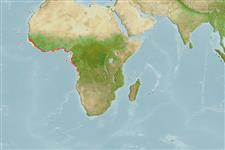>
Eupercaria/misc (Various families in series Eupercaria) >
Sciaenidae (Drums or croakers)
Etymology: Pseudotolithus: Greek, pseudes = false + greek, otos = ear + Greek, lithos = stone (Ref. 45335).
More on author: Bleeker.
Environment: milieu / climate zone / depth range / distribution range
Ecologia
marinhas; Água doce; estuarina demersal; intervalo de profundidade 0 - 160 m (Ref. 3593). Tropical; 12°N - 17°S
Eastern Atlantic: Guinea-Bissau (Ref. 26999) to southern Angola (Ref. 3593, 81656). Possibly also occurring more to the north (Ref. 81656).
Tamanho / Peso / Idade
Maturity: Lm ? range ? - ? cm
Max length : 60.0 cm TL macho/indeterminado; (Ref. 3593); common length : 35.0 cm TL macho/indeterminado; (Ref. 3593)
Espinhos dorsais (total) : 10; Raios dorsais (total) : 35 - 39; Espinhos anais: 2; Raios anais : 7. Diagnosis: moderately sized species with an elongate and laterally compressed body; dorsal with 9 (10?) spines in 1st part, second part with 1 spine and 35-39 soft fin rays; second anal spine clearly shorter than first anal fin soft ray, i.e. about half its length, and robust; pectoral fins long, 23.3-27.3% SL; caudal fin S-shaped; mouth inferior almost horizontal; maxilla extending to posterior half of eye; 7-9/1/4-7 (total 13-18) gill rakers on 1st gill arch; lower part of 1st gill arch with 2-6 reduced additional gill rakers, upper part with 0-2 reduced additional ones; gill rakers moderately long and fine, but shorter than the gill filament at angle between lower and upper part of gill arch; preopercular edge feebly denticulated but never with spines; eyes rather small, 4.6-5.4 times in HL, but this character is difficult to use for identification because of allometry (Ref. 81656).
Coloration: generally very dark, but occasionally pale silver often with faint dark brown oblique lines on sides; ventral side of head and belly yellowish; all fins greyish to very dark brown, black (Ref. 81656).
Occurs in coastal waters from the shore to about 70 m over mud bottom, but moves to deeper water. Also found in estuaries and coastal lagoons (Ref. 3593, 81656). Mainly feeds on benthic invertebrates (Ref. 81656).
Ciclo de vida ou comportamento de acasalamento
Maturities | Reprodução | Spawnings | Egg(s) | Fecundities | Larvas
Chao, L.N. and E. Trewavas, 1990. Sciaenidae. p. 813-826. In J.C. Quero, J.C. Hureau, C. Karrer, A. Post and L. Saldanha (eds.) Check-list of the fishes the eastern tropical Atlantic (CLOFETA). JNICT, Lisbon; SEI, Paris; and UNESCO, Paris. Vol. 2. (Ref. 3593)
Status na Lista Vermelha da UICN (Ref. 130435)
Ameaça para os humanos
Harmless
Uso pelos humanos
Pescarias: espécies comerciais
Ferramentas
Relatórios especiais
Baixar XML
Fontes da internet
Estimates based on models
Preferred temperature (Ref.
123201): 19.2 - 27.9, mean 26 °C (based on 102 cells).
Índice de diversidade filogenética (Ref.
82804): PD
50 = 0.5156 [Uniqueness, from 0.5 = low to 2.0 = high].
Bayesian length-weight: a=0.00575 (0.00278 - 0.01190), b=3.11 (2.93 - 3.29), in cm total length, based on LWR estimates for this (Sub)family-body shape (Ref.
93245).
Nível Trófico (Ref.
69278): 3.6 ±0.6 se; based on size and trophs of closest relatives
Resiliência (Ref.
120179): médio(a), tempo mínimo de duplicação da população 1,4 - 4,4 anos (Preliminary K or Fecundity.).
Fishing Vulnerability (Ref.
59153): Moderate vulnerability (44 of 100).
Nutrients (Ref.
124155): Calcium = 114 [62, 210] mg/100g; Iron = 0.872 [0.469, 1.499] mg/100g; Protein = 18.7 [17.5, 19.8] %; Omega3 = 0.156 [0.078, 0.287] g/100g; Selenium = 75.1 [39.5, 144.8] μg/100g; VitaminA = 15.5 [6.1, 43.4] μg/100g; Zinc = 1.15 [0.82, 1.64] mg/100g (wet weight);
